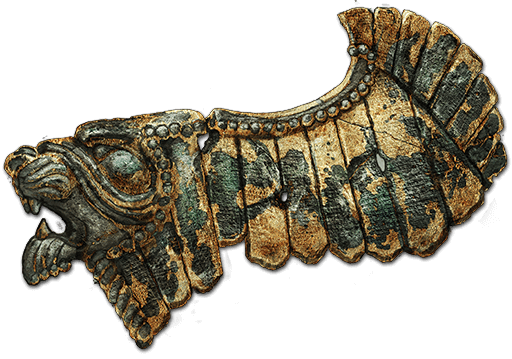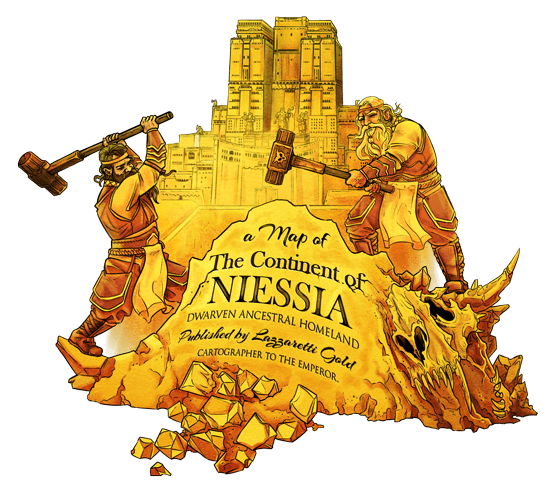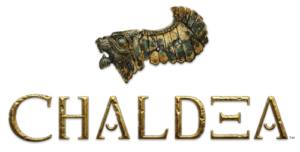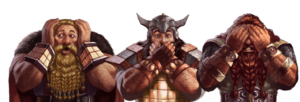S T O L L H O F E N
 Stollhofen is a somewhat-developed inland kingdom that shares a large border with Niesse to the southeast, Salominica to the southwest, Munchkein to the northwest, a smaller border with Hesse to the north, and Himyar to the northeast.
Stollhofen is a somewhat-developed inland kingdom that shares a large border with Niesse to the southeast, Salominica to the southwest, Munchkein to the northwest, a smaller border with Hesse to the north, and Himyar to the northeast.
The southern half of Stollhofen is unpopulated with arid, wild hills that lead into Niesse and the orc empire, a veritable no-man’s-land buffer between humans and creatures of hate. The northern portion of Stollhofen is lush by comparison, well fortified and populated by humans and dwarves who live in a perpetual state of military readiness against a feared invasion by orcs. These southern and northern territories are separated by a dry, flat valley, one devoid of life and heavily patrolled by Stollhofen horse.
Population. The majority of the population of Stollhofen are human but with a sizeable representation of dwarves as well. In fact, Stollhofen hosts the largest population of dwarves in all of Chaldea. Many of Stollhofen’s citizens are segregated with the humans living along the Emscher River, especially near the capital city of Hallistat—the largest city of Stollhofen, lying at the fork of the Emscher and Lippe Rivers. The dwarven population lives mostly underground with access to the surface via the great dwarven fortress of Kurighaul.
The exception to segregation are the three villages of Rockhaul, Orchammerhaul, and Morikhaul, which are jointly populated and administered by humans and dwarves. The threat of an orc invasion creates a significant bond of unity and common purpose between the humans and dwarves of the nation.
Government. The human government of Stollhofen is a monarchy. As monarchies go, Stollhofen has proven quite stable, with the royal family of Pauli in place for nearly 200 years. The kings and queens of Stollhofen have engaged in a deliberate tradition of polygamy and group marriage, guaranteeing a large and complex network of peerage that has well served the royal family and perhaps even the nation itself.
While humans rule the overall kingdom, the dwarves are a self-governed protectorate of Stollhofen. This protectorate is ruled by Kane Kurig, who also commands the Hecks.
Military. The people of Stollhofen believe there will ultimately be a war with the orc empire of Niesse, which across their southeastern border. The dwarves in particular believe it’s not a question of if but a question of when. Apparently, Governor Hellwig Gustavus agrees, as there are three cohorts of the 10th Legion quartered at a castrum just outside of Hallistat.
The Hecks have a sizeable military operation in Stollhofen as well. The Hecks are a federation of all the knight orders of the Hessen peoples, which includes the kingdoms of Hesse, Munchkein, Stollhofen, and Tetonique. Grand Master Kane Kurig commands the Hecks, and all male humans of Stollhofen are required to serve three years in the military, creating a vast army of reserves that can be called upon to serve in the various knight orders across Stollhofen. Favored weapons are swords and crossbows, and these forces are organized into horsemen, archers, and men-at-arms.
If the 10th Legion and the Hecks aren’t enough, there is also the Dwarven Host to consider. Not just the men but the dwarven women are required to serve in the Host for ten out of every hundred years of their lifespan. Since dwarves often live four or five centuries, some dwarven “reservists” have actually spent an entire human’s lifetime in the military. Favored weapons are axes, siege weapons, and crossbows, and they are organized into axe bearers, artillerists, and archers.
United in this anticipation of eventual war with the orcs, humans and dwarves have collaborated to create the military fortress-villages of Rockhaul, Orchammerhaul, and Morikhaul. Each of these villages has an integrated population of humans and dwarves who live off the land normally but with a combined arms approach to military defense. In these communities, called Cantons, military training is required of all citizens, humans and dwarves alike.
Finally, the hills of Stollhofen are riddled with trenches, underground tunnels, and hidden caches of weapons, armor, and supplies. Many of these are heavily trapped.
Ethnicity. The humans of Stollhofen are of Hessen ethnicity. Dwarves of Chaldea are not divided into ethnic varieties but are instead organized into clans. Because marriages are typically cross-clan to avoid inbreeding, there is little distinction between the dwarves of one clan versus another. There are several dwarven clans in Stollhofen, the most prominent being Rock, Kurig, Orchammer, and Morik.
In Hallistat, one might find the occasional elf, halfling, gnome, or even outcast orc in servitude, but these do not exist in meaningful numbers.
Economy & Currency. Human are primarily herders, ranchers, and gardeners; dwarves are primarily metalsmiths and tradesmen. Exports are metal works, wool, and pork. For currency, humans use the monies of Hesse, silver pfennigs, silver half-groschen (5 pfennigs), and the silver groschen (10 pfennigs). Dwarves use bullion rings threaded on metal wires or into their beards.
History
Diaspora. During the Claw-Hammer War, the orcs of the dragon armies defeated the dwarves in the Divinity Mountains. Some of the dwarven refugees who survived that war settled (and hid) in the hills of Stollhofen, emerging as a modest dwarven community after the war.
Hessen Arrivals. As the Hessens drove the Andals out of Niessia, new Hessen knight orders, hungry for more land, began claiming territory in present-day Stollhofen. This led to recurring conflicts between humans and dwarves from about –600 to –400.
Hessen Dominance. Eventually, the Hessens defeated the dwarves and forced them into submission around Year –400.
Hessen Civil War. During the long and bloody Hessen Civil War, from Year –250 to Year –168, the dwarves were permitted to arm themselves and join the local knight orders, eventually gaining protectorate status in the newly formed kingdom of Stollhofen in Year –168. The goal of some dwarves, however, was to be awarded the coveted Enchantment’s Guard and some of the surrounding land if they won the civil war. Some historians believe the war could have ended fifty years earlier, had the dwarves relinquished this dream. Eventually, however, fatigue from nearly a century of fighting led the humans to sign a treaty ending the war called the Peace of Kofin.
Hessen Rebellion. In Year 5, Stollhofen joined Hesse and Munchkein in a rebellion against Emperor Kordaava. The rebellion was put down by the 10th Legion, backed by powerful auxilia units of Ardayan Trinity and Hakhamanesh Thunder.
Provincial Niessia. In Year 7, Hellwig von Gustavus was appointed governor of the Province of Niessia, which included Stollhofen and all the kingdoms of the Niessia continent. Shortly thereafter, the knight orders of Stollhofen and Munchkein were brought under Imperial control through forced integration of the orders with the Hecks.
C H A L D E A P E D I A











